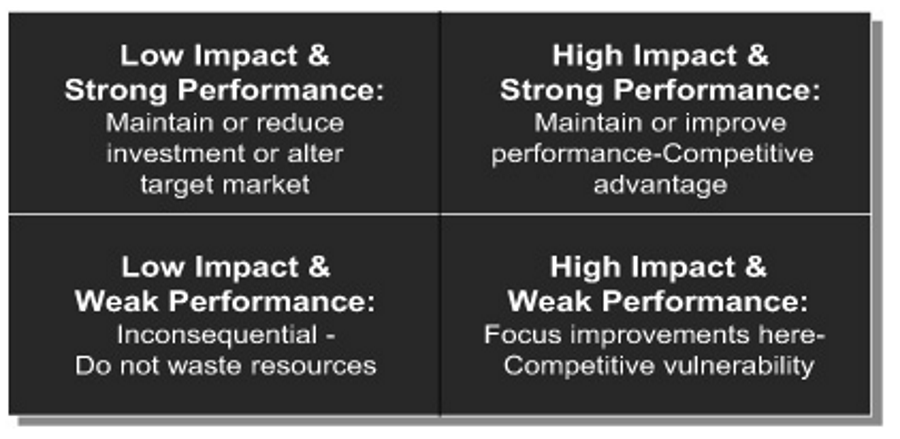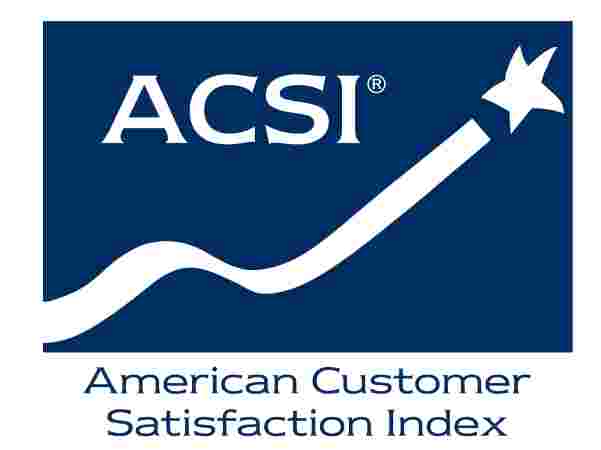
Adapted from Dr. Claes Fornell's book | September 10, 2018
The Satisfied Customer: Winners and Losers in the Battle for Buyer Preference
The strategically aligned firm optimizes the use of its resources by separating the relevant from the irrelevant and is much more likely to reap subsequent financial returns.
There are two critical inputs to Customer Asset Management:
- IMPACT - the impact or effect of different aspects of the product and the customer experience (such as customization, reliability, price, etc), and
- PERFORMANCE - the level of company performance, in the eyes of the customer, on these aspects, either in an absolute sense or relative to competitors.
CUSTOMER PRIORITY MATRIX

Weak performing attributes with high impact should be the first priority for improvement. For example, many companies perform poorly on service reliability, which often has a large impact on satisfaction.
Strategically aligned companies are those that perform well in areas that have the greatest impact on customers, do not waste resources improving areas of little or no importance to customers, and get the basics right.
High performing areas with a high impact are difficult to improve. Product customization is typically a high impact area for many nondurable product manufacturers, but most competitors do well on this dimension. Even a small lead may reveal a competitive advantage leading to greater profits, but it can be difficult to reach such high.
When impact is low and performance weak, the data suggest that the customer neither demands nor is willing to pay for improvements, and efforts aimed at increasing satisfaction should be focused elsewhere.
Finally, when impact is low and performance is strong, the data suggest that these qualities are taken for granted by the customer—they reflect a basic requirement for entry into the market—and that improvement efforts should be allocated to higher impact areas.
Strategically aligned companies are those that perform well in areas that have the greatest impact on customers, do not waste resources improving areas of little or no importance to customers, and get the basics right. Often there are important differences between high-performance and low-performance companies. Though both types of firms tend to perform more or less the same in low-impact areas, high-performance companies simply perform much better in high-impact areas.
The idea of strategic alignment can best be illustrated dynamically. Let's start with the disaster scenario.
DISASTER SEQUENCE

The starting point is a customer satisfaction matrix with "entries" in each quadrant. That is, there are attributes that have a high impact on customer satisfaction where we do well and there are attributes that have a high impact where we don't. Conversely, there are attributes with low impact—on some of these we do well, and on others we don't.
The next matrix in the sequence illustrates the risk of adhering too closely to principles of Total Quality Management or Six Sigma, which calls for improvements in all weak areas. As suboptimal as this strategy is, it is still quite common in many companies, founded on the idea that whatever customers consider weak points or areas of underperformance, the firm needs to improve. However, such a strategy demands much more effort than is needed. It also leaves the firm vulnerable to customization attempts by competitors.
In the disaster scenario, competitors become successful in shifting the salience of attributes that we do well on toward low impact. The end result is that in areas where we are strong, customers don't care and where we are weak, customers care a lot. No firm can survive under such circumstances.
Now let's look at the successful scenario.
SUCCESSFUL SEQUENCE

In a successful scenario, we would target low performing high-impact attributes for improvement and work to maintain superiority in high-impact areas where we are already performing well.
As a result, the strategically aligned firm will expend far fewer resources on those attributes which, whether performing well or poorly, mean little to the satisfaction of its customers. Other attributes will be monitored, but as long as they have little impact, they warrant no action.
The strategically aligned firm is optimizing the use of its resources by separating the relevant from the irrelevant and is much more likely to reap subsequent financial returns.
Other Resources
- Date
- September 7, 2023
by David Ham | September 7, 2023 With the amount of money involved in professional sports contracts, the current trend toward deeper analysis makes good business sense. However, […]- Date
- June 2, 2023
by David Ham June 1, 2023 I will start by stating the obvious, inflation is forcing consumers to make tradeoffs and difficult decisions. This puts businesses […]- Date
- August 1, 2022
by David Ham August 1, 2022 Five years ago, I wrote a blog that asked, Is This a ‘Hook-Up’ or a Long-Term Relationship? The post was […]- Date
- May 24, 2022
by Omar Khan May 24, 2022 A few years before getting my first job as a consultant, I spent a summer abroad in the United Arab […]





